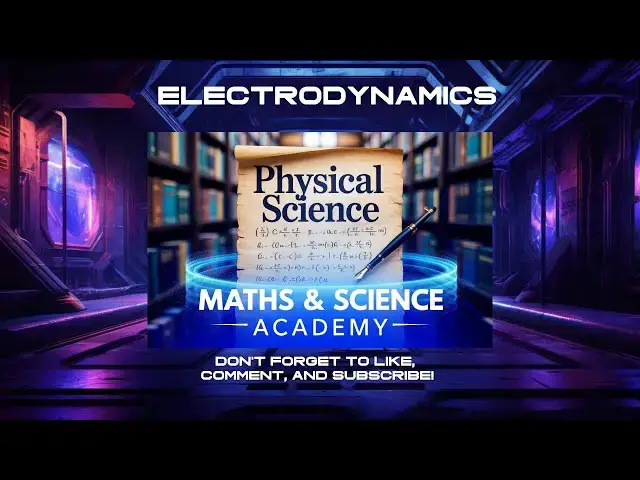0:07
welcome to Maths and Science Academy in
0:09
this video we will be looking at part
0:25
part one of this video we trying to
0:27
understand this simulation consisting of
0:29
only a magnet a light bulb and wires
0:32
starting off with only one loop of
0:33
copper wire two loops up until four
0:35
loops and moving the magnet around we
0:38
can eventually see electricity being
0:39
generated in this case we are going to
0:42
refer the movement of the magnet inside
0:44
the loop as mechanical energy hence the
0:47
moving energy resulting into electrical
0:49
energy from this we were able to define
0:52
what is magnetic flux what is
0:54
electromagnetic induction and we were
0:57
able to define Faraday's law of
0:59
electromagnetic induction ded as the
1:02
induced TMF in a conductor is directly
1:04
proportional to the rate of change of
1:06
the magnetic flux in the conductor where
1:08
N is the number of turns in the coil e
1:10
is emf the electromagnetic force in
1:13
volts delt is change in magnetic flux in
1:16
Weber and delta T is change in time in
1:18
seconds the negative sign shows that the
1:21
emf creates a current and a magnetic
1:23
field that opposes the change in the
1:25
magnetic flux electronamics is the study
1:28
of the relationship between electricity
1:30
magnetism and mechanical phenomena
1:34
what are Fleming's left and right hand
1:36
rules the thumb represents the force
1:39
resulting in the motion of the wire in
1:41
the magnetic field first finger
1:43
represents the magnetic field the first
1:45
finger always points towards the south
1:47
pole of the magnet then the second
1:49
finger represents the direction of the
1:51
current in the wire the simulation shows
1:54
that the magnetic lines of force from
1:56
the external field extend from the north
1:58
end to the southeast pole moving left to
2:00
right resulting to the clockwise
2:02
rotation of the wire this is a
2:04
simulation of a motor because there is
2:06
either an AC or DC power supplying
2:08
electricity and electricity is then
2:11
converted into mechanical energy the
2:13
movement or the clockwise rotation of
2:15
the coil fleming's left-hand rule is
2:18
used in motors an electrical machine is
2:21
a device that converts mechanical energy
2:23
into electrical energy and vice versa a
2:25
motor is a type of electrical machine
2:27
that converts electrical energy into
2:29
mechanical energy this motor can either
2:31
run on AC electrical energy or DC
2:33
electrical energy therefore the motors
2:36
are classified into two main types AC
2:39
motor and DC motor both types of motor
2:41
generate mechanical energy used for
2:43
moving any mechanical load etc but their
2:45
construction control efficiency and
2:47
applications are quite different you
2:49
know more about the basic information
2:51
about a C and DC current and voltage in
2:53
the previous slide which you need to
2:55
study briefly this motor can either run
2:57
on a C electrical energy or DC
3:00
electrical energy supply as this
3:02
simulation illustrates we can see that
3:04
as the electrical energy is being
3:06
converted into mechanical energy and by
3:08
using Fleming's left-h hand rule in
3:10
motors the thumb represents the force
3:12
resulting in the motion of the wire in
3:14
the magnetic field first finger
3:16
represents the magnetic field the first
3:18
finger always points towards the south
3:20
pole of the magnet then the second
3:22
finger represents the direction of the
3:27
fleming's right- hand rule is used in
3:30
similarly when a conductor is moved
3:32
forcefully into a magnetic field an
3:34
induced current results the direction of
3:37
this current can be determined using
3:38
Fleming's right- hand rule
3:47
part one of this video we saw consisting
3:50
of only a magnet a light bulb and wires
3:53
moving the magnet around we can
3:54
eventually see electricity being
3:56
generated in this case we are going to
3:58
refer the movement of the magnet inside
4:00
the loop as mechanical energy hence the
4:03
moving energy resulting into electrical


